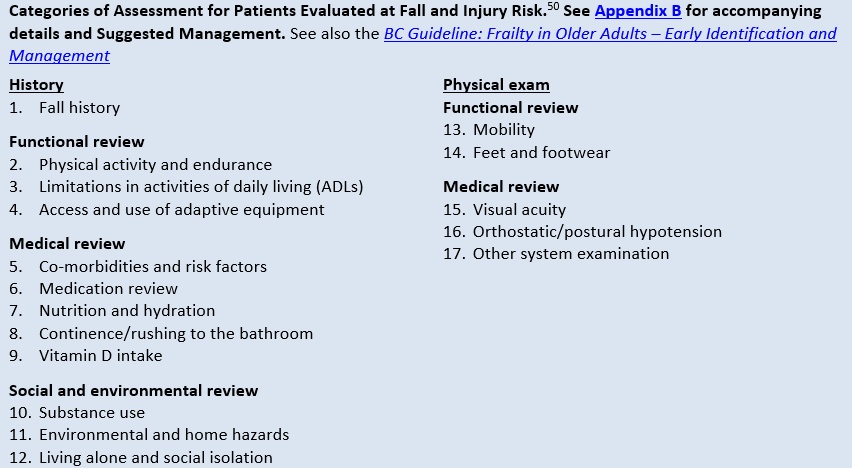Dementia Fall Risk for Beginners
Table of ContentsThe 10-Second Trick For Dementia Fall RiskNot known Details About Dementia Fall Risk The Dementia Fall Risk IdeasAn Unbiased View of Dementia Fall Risk
A fall threat assessment checks to see just how most likely it is that you will certainly drop. It is mainly provided for older adults. The analysis generally includes: This includes a collection of questions about your total health and wellness and if you've had previous drops or issues with balance, standing, and/or strolling. These tools examine your toughness, equilibrium, and gait (the method you walk).Interventions are suggestions that might reduce your danger of dropping. STEADI consists of three actions: you for your threat of dropping for your threat elements that can be boosted to try to avoid falls (for instance, balance troubles, impaired vision) to reduce your danger of dropping by making use of reliable techniques (for example, providing education and learning and resources), you may be asked several concerns including: Have you fallen in the past year? Are you worried about dropping?
You'll sit down once more. Your supplier will examine how much time it takes you to do this. If it takes you 12 secs or even more, it may indicate you are at higher threat for an autumn. This test checks strength and balance. You'll sit in a chair with your arms crossed over your breast.
The placements will certainly obtain more difficult as you go. Stand with your feet side-by-side. Move one foot midway forward, so the instep is touching the big toe of your other foot. Relocate one foot totally before the other, so the toes are touching the heel of your various other foot.
A Biased View of Dementia Fall Risk
A lot of drops take place as an outcome of several contributing aspects; as a result, handling the risk of falling begins with recognizing the aspects that add to drop threat - Dementia Fall Risk. Several of the most appropriate risk aspects include: Background of previous fallsChronic clinical conditionsAcute illnessImpaired gait and equilibrium, reduced extremity weaknessCognitive impairmentChanges in visionCertain high-risk medicines and polypharmacyEnvironmental variables can also increase the risk for falls, consisting of: Insufficient lightingUneven or damaged flooringWet or slippery floorsMissing or damaged hand rails and get hold of barsDamaged or poorly equipped devices, such as beds, mobility devices, or walkersImproper usage of assistive devicesInadequate guidance of individuals living in the NF, including those who exhibit hostile behaviorsA successful autumn threat administration program requires a complete professional evaluation, with input from all members of the interdisciplinary team

The care plan must likewise consist of interventions that are system-based, such as those that advertise a risk-free atmosphere (suitable illumination, hand rails, get bars, etc). The efficiency of the treatments should be examined periodically, and the treatment plan revised as necessary to reflect adjustments in the loss threat analysis. Carrying out an autumn risk monitoring system making use of evidence-based finest method can minimize the prevalence of falls in the NF, while limiting the possibility for fall-related injuries.
The Definitive Guide to Dementia Fall Risk
The AGS/BGS this hyperlink standard recommends screening all adults aged 65 years and older for autumn threat yearly. This screening includes asking patients whether they have actually fallen 2 or more times in the previous year or looked for medical focus for an autumn, or, if they have not dropped, whether they feel unsteady when walking.
People that have dropped once without injury ought to have their balance and stride reviewed; those with stride or equilibrium problems need to get added analysis. A history of 1 autumn without injury and without stride or equilibrium issues does not necessitate additional analysis beyond ongoing annual loss risk testing. Dementia Fall Risk. A fall danger assessment is required as component of the Welcome to Medicare evaluation
-copy-5.jpg)
5 Simple Techniques For Dementia Fall Risk
Recording a falls background is one of the top quality indications for fall avoidance and management. A vital part of risk assessment is a medicine evaluation. Numerous classes of medications increase loss threat (Table 2). copyright drugs in particular are independent predictors my review here of drops. These medicines tend to be sedating, change the sensorium, and harm equilibrium and gait.
Postural hypotension can often be reduced by minimizing the dosage of blood pressurelowering medicines and/or quiting medications that have orthostatic hypotension as an adverse effects. Use above-the-knee support tube and copulating the head of the bed elevated may additionally reduce postural reductions in high blood pressure. The suggested components of a fall-focused checkup are displayed in Box 1.

A pull time above or equal to 12 secs recommends high fall risk. The 30-Second Chair Stand test assesses lower extremity strength and balance. click now Being incapable to stand up from a chair of knee height without utilizing one's arms indicates increased autumn threat. The 4-Stage Equilibrium examination assesses fixed balance by having the client stand in 4 positions, each progressively more difficult.